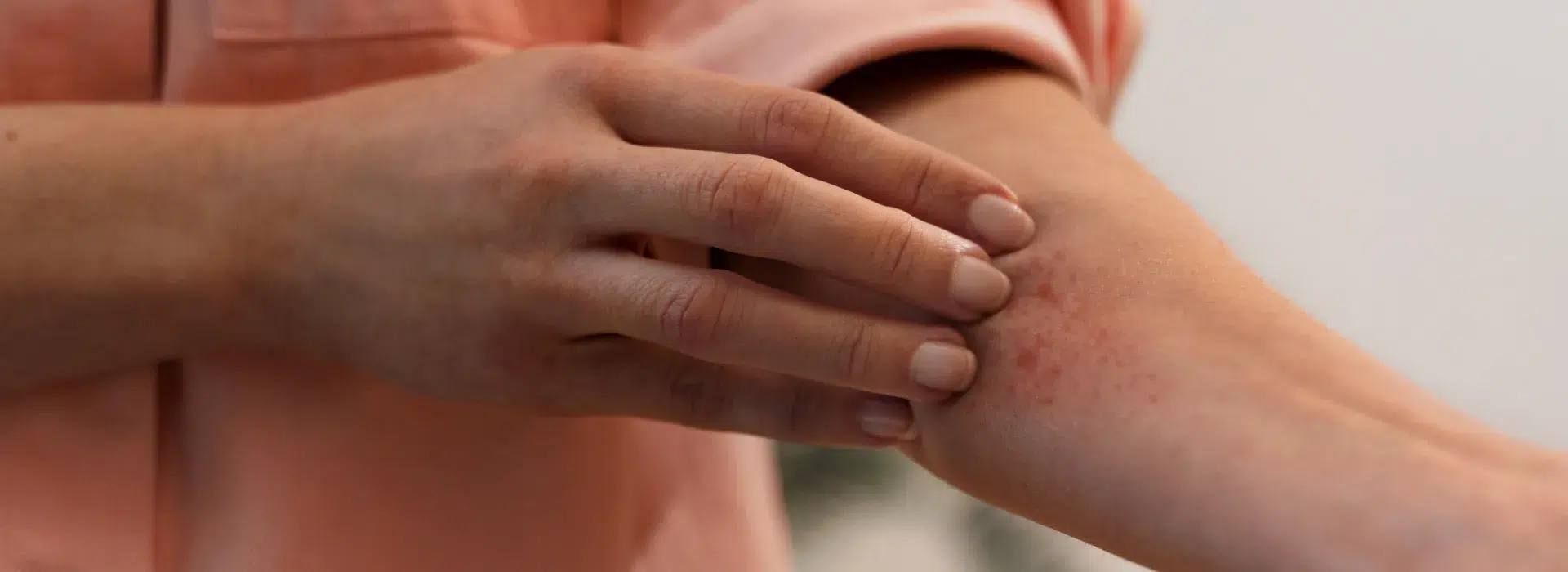Fungal skin infection: Types and home remedies
Written by Priyanka Agarwal, Writer at Hola Health Medically reviewed by Dr Gosagan Gopalakrishnan, BSc (Hons), MBChB, DRCOG, MRCGP, FRACGP

Contents

Fungal skin infections are highly prevalent affecting nearly a billion people worldwide1. They are common skin disorders caused by various fungi that agitate the skin, hair, and nails. These infections can vary from minor to critical, affecting individuals of all ages and backgrounds. Let’s learn more about these infections and their preventive measures for effective management and care.
What are fungal infections?
Fungal infections are diseases caused by overgrowth or infestation of fungi in the body. They can also be found as moulds, yeasts, or mushrooms. While many fungi are non-harmful and useful, some can lead to infections, especially when they increase rapidly or penetrate body tissues. They can be classified into superficial infections, such as tinea (ringworm), and candidiasis (yeast infections), which influence the skin, hair, and nails; subcutaneous (deeper) infections that penetrate the skin barrier due to damage; and systemic infections that impact internal organs, like histoplasmosis and coccidioidomycosis. Symptoms differ based on the type and location of the infection and may include itching, rashes, redness, and nail discolouration. Contributing factors for these infections comprise warm and moist environments, poor hygiene, and weak immune systems.What does a fungal infection look like?
Fungal infections can manifest in various ways depending on the fungus type and the targeted area. Superficial infections like ringworm (tinea) usually appear as round, red, itchy spots with elevated borders and clear centres, while athlete’s foot (tinea pedis) exhibits redness, itchiness, and flaking skin between the toes, sometimes accompanied by blisters. Jock itch (tinea cruris) displays a red, itchy rash in the groin area. Yeast infections, such as thrush may trigger white patches in the mouth or throat, while genital yeast infections give rise to a red, itchy rash with thick white discharge. Nail fungal infections (onychomycosis) may cause discoloured and brittle nails. Subcutaneous fungal infections can result in painful bumps or ulcers, while systemic fungal infections may have hidden symptoms without external manifestations.Are fungal infections contagious?
Fungal diseases can be infectious. Dermatophyte diseases such as athlete's foot, ringworm, and jock itch are transmitted by direct skin-to-skin contact or infected things such as towels, clothes, or by walking barefoot in a public changing room. Yeast infections, such as candidiasis, can spread by direct touch or shared objects but are less infectious. Systemic fungal infections, which affect internal organs, are often not contagious and are transmitted by breathing fungal spores rather than by direct person-to-person contact. To prevent the spread, practice cleanliness, avoid sharing personal belongings, and treat diseases as soon as possible.Types of fungal infections
Here are some common types of fungal infections, their causes, and symptoms:Athlete's Foot:
Athlete's Foot (Tinea Pedis) is caused by dermatophytes, a fungi that flourish in warm, damp conditions. This infection is frequently seen between the toes or on the soles of the feet. The symptoms include severe itching, a burning feeling, and redness. The skin may peel and break, occasionally resulting in blisters. The illness frequently spreads in shared spaces such as changing rooms and swimming pools, where fungus may readily live and spread.Ringworm:
Ringworm (Tinea Corporis) is a highly infectious fungal illness caused by dermatophytes that can spread through direct contact with sick persons or contaminated goods. It appears as an itchy, circular rash with a raised, red border and a clear centre, giving it a ring-shaped look. This illness can affect many body parts, such as the arms, legs, and torso, and is often contracted in environments where people are in close contactAspergillosis:
Aspergillosis is caused by breathing spores from the Aspergillus fungus, often present in decomposing organic waste. Symptoms vary according to the kind of aspergillosis. Common symptoms include coughing, chest discomfort, and trouble breathing. In severe or chronic cases, it can cause major lung damage and systemic infections, especially in people with weakened immune systems.Histoplasmosis:
Histoplasmosis is caused by breathing spores from Histoplasma capsulatum, a fungus prevalent in soil contaminated with bird or bat droppings. Symptoms might range from minor flu-like symptoms including fever, cough, and chest discomfort to more serious breathing problems. In situations where this has gone on for some time, the infection might harm the lungs and other organs, necessitating medical attention for correct treatment.Jock itch:
Jock Itch (Tinea Cruris) is a dermatophyte-caused ailment that often affects the groin area. It appears as an itchy, red rash with a distinct border in the groin and inner thighs. The illness might also extend to the buttocks and genitals. It is frequently exacerbated by tight clothes and extensive perspiration.Candidiasis:
Candidiasis (Yeast Infection) is caused by an excess of Candida yeast, namely Candida albicans. This infection can be present in several areas: Oral thrush creates white spots in the mouth, whereas vaginal candidiasis causes itching, redness, and discharge. Skin candidiasis causes red and itchy rashes in skin folds. Antibiotic usage, a compromised immune system, or hormonal changes can all lead to overgrowth.Home remedies
Here are some home remedies for common fungal infections:- Tea tree oil: Tea tree oil is known for its strong antifungal qualities and can be used to treat a variety of fungal illnesses. Dilute a few drops with a carrier oil (such as coconut or olive oil) and apply to the afflicted region twice every day.
- Coconut oil: Coconut oil contains medium-chain fatty acids, which have antifungal effects. Use pure coconut oil directly on affected skin or nails, or as a basis for additional medical treatments.
- Apple cider vinegar: Vinegar's acidity can help prevent fungal development. Dilute apple cider vinegar with equal parts water and apply to the diseased region with a cotton ball or use it as a foot soak.
- Garlic: Garlic contains natural antifungal effects. Crush a few cloves, blend with a touch of coconut oil, and apply it to the affected area. Alternatively, consume raw garlic to support overall health.
- Colloidal oatmeal: Adding colloidal oatmeal to a bath helps relieve itching and irritation from fungal infections. It's very effective for skin infections.
- Probiotics: Adding probiotics to your diet, such as yoghurt or fermented foods, can help restore your body's natural balance of bacteria and minimise fungal overgrowth.
When to see a doctor?
If your fungal infection's symptoms persist or worsen after home treatment, you should consult a doctor. Seek medical assistance if the illness extends to sensitive places such as the genitals, face, or nails. If you have a weaker immune system due to diabetes, HIV, or chemotherapy, or if the illness causes substantial discomfort or interferes with your everyday activities, get expert help. Consult a online doctor if over-the-counter medications do not work or if you develop secondary symptoms such as fever, oedema, or pus. Early diagnosis and treatment can help to avoid complications and control fungal infections effectively.How can Hola Health help?
Hola Health offers a full range of telehealth services that cater to various health needs right from the comfort of your home, helping to reduce the risk of spreading illness:- Online doctor Consultations - Consult with a health practitioner within 15 minutes from the safety of your home. This service eliminates the need for travel and reduces wait times. Our medical experts provide advice, diagnosis, and treatment for a wide range of conditions, including fungal infections and other skin issues.
- Online Prescriptions - Easily get prescriptions online from a registered health practitioner, making it a quick and convenient way to access necessary medications.
- Medical Certificates - If you need leave from work, school, or university—or need to care for someone with scabies—you can receive a medical certificate online in minutes from AHPRA-registered medical practitioners.
- Online Referrals - Get referrals to skin specialists online without leaving your home, making it easier to manage your condition without the need for travel.
- Online Medicine Delivery - When dealing with a contagious illness, online medicine delivery can be invaluable. Schedule your delivery or opt for same-day pharmacy delivery through Hola.
Feeling sick and unsure why? Speak with a GP online in 15 minutes.
See a Doctor now
Available 24/7, across Australia.
Feeling sick and unsure why? Speak with a GP online in 15 minutes.
See a Doctor now
Available 24/7, across Australia.
What we treat
- Cough
- Nausea & vomiting
- Fever
- Hayfever
- Fatigue
- Sore throat
- Acne
- Hair loss
- Gout
- Eczema
- Rosacea
- Sunburn
- UTI
- Erectile dysfunction
- Contraception
- Morning sickness
- Morning after pill
- Prostate health
- Anxiety
- Depression
- Stress
- Grief & loss
- Antidepressants
- Premature ejaculation
- Asthma
- Blood pressure
- Blood thinners
- Diabetes
- Cholesterol
- Migraines & headaches
- Allergies
- Body ache
- Heartburn & reflux
- Sleep disorder
- Pain relief
- Gastro
Related Articles
Disclaimer
This blog is for general informational purposes only and does not indicate that Hola Health provides all treatments or preventive measures mentioned. It is not intended to be a substitute for professional medical advice. Always seek the guidance of your doctor or other qualified health professional with any questions you may have regarding your health or a medical condition. For emergencies please immediately contact 000. Any medical topics discussed are intended to educate, not to imply availability through Hola Health.
 Facebook
Facebook  X
X  Copy Link
Copy Link



